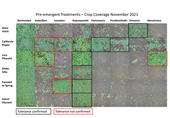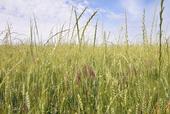- Author: Drew Lyon
- Posted by: Gale Perez

Herbicides are an important tool for the management of weeds in crops but an overreliance on herbicides for weed management has accelerated the development of herbicide-resistant weed biotypes. Staying ahead of the biology of herbicide resistance requires a sound understanding of the process and the other tools that are available to manage weeds. To help, we recently added several new resources on the WSU Wheat and Small Grains website about the ever-evolving topic of herbicide resistance. You may want to check them out:
- Author: Ryan Hill
- Author: Marcelo Moretti

Introduction:
Pollinator insects are essential to produce many economically and nutritionally important crops grown in the western USA. These crops include blueberries, almonds, sunflowers, cucurbits, and many others. Almond pollination in California plays a vital role in the apiary industry, driving beekeepers to haul huge numbers of bee colonies to California for the few weeks in late winter when almonds bloom. Bees are selective of the pollen and nectar they forage, and diverse floral resources can allow bees to forage according to their nutritional needs (Leponiemi et al. 2023). Planting pollinator habitat in natural areas, gardens, and agricultural land is one method of supporting bee health....
- Author: Drew Lyon
- Posted by: Gale Perez

In my previous position as the Extension Dryland Cropping Systems Specialist with the University of Nebraska Panhandle Research and Extension Center in Scottsbluff, I focused my research efforts on intensifying and diversifying the winter wheat-fallow cropping system. The addition of summer crops into the rotation was a first step. Inserting summer crops such as proso millet, sunflower, or corn reduced the frequency of summer fallow from every other year to once every three years. Summer crops also helped in the management of winter annual grass weeds such as downy brome, jointed goatgrass, and feral rye. As I looked for ways to eliminate summer fallow from the rotation, my attention turned to forage...
- Author: Jorge Antonio Angeles
- Posted by: Gale Perez

Silverleaf nightshade, Solanum Elaeagnifolium, is perennial weed that is native to South America, Mexico, American Southwest and Southern States. This herbaceous and woody summer weed belongs to Solanaceae just like other weeds such as black nightshade (Solanum nigrum), hairy nightshade (Solanum physalifolium) and horsenettle (Solanum carolinense). It can be found throughout California and in grows in desert and semi-arid areas. Silverleaf nightshade is often found growing in different cropping systems, rangeland, pastures, roadsides, and disturbed areas. Silverleaf nightshade is highly adaptable and can tolerate a wide range of soil and climatic conditions such as high temperatures, low rainfall,...
- Posted by: Gale Perez

Position title: Assistant Professor of Extension/Assistant Cooperative Extension Specialist in Weed Management in Agronomic Crops
Job #JPF01902
Location: Riverside, CA
APPLICATION WINDOW
Open date: April 17, 2024
Next review date: Wednesday, Jun 12, 2024 at 11:59pm (Pacific Time)
Apply by this date to ensure full consideration by the committee.
Final date:...


